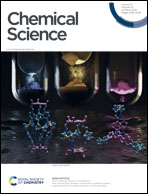Near-infrared fluorescent probe for hydrogen sulfide: high-fidelity ferroptosis evaluation in vivo during stroke†
Abstract
Ferroptosis is closely associated with cancer, neurodegenerative diseases and ischemia-reperfusion injury and the detection of its pathological process is very important for early disease diagnosis. Fluorescence based sensing technologies have become excellent tools due to the real-time detection of cellular physiological or pathological processes. However, to date the detection of ferroptosis using reducing substances as markers has not been achieved since the reducing substances are not only present at extremely low concentrations during ferroptosis but also play a key role in the further development of ferroptosis. Significantly, sensors for reducing substances usually consume reducing substances, instigating a redox imbalance, which further aggravates the progression of ferroptosis. In this work, a H2S triggered and H2S releasing near-infrared fluorescent probe (HL-H2S) was developed for the high-fidelity in situ imaging of ferroptosis. In the imaging process, HL-H2S consumes H2S and releases carbonyl sulfide, which is then catalyzed by carbonic anhydrase to produce H2S. Importantly, this strategy does not intensify ferroptosis since it avoids disruption of the redox homeostasis. Furthermore, using erastin as an inducer for ferroptosis, the observed trends for Fe2+, MDA, and GSH, indicate that the introduction of the HL-H2S probe does not exacerbate ferroptosis. In contrast, ferroptosis progression was significantly promoted when the release of H2S from HL-H2S was inhibited using AZ. These results indicate that the H2S triggered and H2S releasing fluorescent probe did not interfere with the progression of ferroptosis, thus enabling high-fidelity in situ imaging of ferroptosis.

- This article is part of the themed collection: Most popular 2022 analytical chemistry articles


 Please wait while we load your content...
Please wait while we load your content...